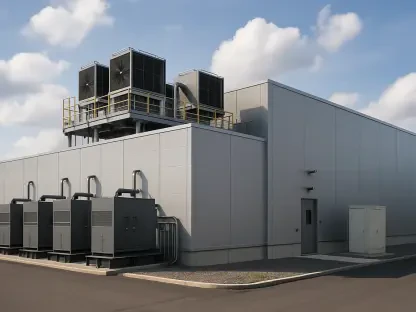Oracle has recently introduced its latest technological marvel, the Exadata X11M, which marks a significant evolution in the company’s renowned Exadata Database Machines. This new iteration embodies Oracle’s continued commitment to developing co-designed hardware and software systems that optimize database performance while ensuring reliability and scalability for a vast array of enterprise customers, ranging from large-scale global corporations to smaller businesses.
The Importance of Transaction Processing in Modern Datacenters
Despite the notable shift of datacenters’ focus away from traditional transaction processing against relational databases, this type of processing remains indispensable for the financial operations of businesses across various industries. Oracle, along with IBM, stands out as one of the few entities that persist in the development of hardware and software solutions to significantly enhance database performance, ensuring both robustness and scalability.
Oracle’s journey in developing engineered systems can be traced back to the introduction of the Exadata X1 machines, which were launched in partnership with HPE’s ProLiant X86 server division. Over the years, Oracle has consistently upgraded its Exadata line, integrating increasingly sophisticated technology to cater to the burgeoning demands of speed and storage capacity in contemporary data environments. The Exadata X11M is the twelfth iteration in this prestigious line, underscoring Oracle’s unwavering dedication to innovation and performance.
Evolution from Exadata X1 to X11M
The Exadata X11M builds upon the foundation laid by its predecessors, with particularly significant advancements over the Exadata X10M. One of the most notable changes was the transition from Intel Xeon processors to AMD Epyc processors in the X10M series, a shift aimed at enhancing computational performance and efficiency. By incorporating AI functionalities directly into the database compute and storage engines without the need for GPUs, the X11M machines rely on advanced vector processing capabilities. This innovative approach allows for dramatic improvements in running data analytics on relational databases, compressing data into faster storage arrays, and accelerating query processing.
Reflecting on Oracle’s history, the company began developing specialized SQL processing and columnar data compression with the Exadata V1 appliances in 2007. These innovations facilitated significant improvements in running data analytics on relational databases, compressing data for faster storage arrays, and boosting query processing efficiency. The separation of SQL processing from database storage tasks enabled both scaling up (handling larger databases) and scaling out (faster query processing). This architectural philosophy has remained integral to Oracle’s approach, culminating in the sophisticated capabilities of the Exadata X11M.
Advanced Hardware Specifications
One of the notable advancements in the Exadata X11M architecture is the shift to a new generation of AMD’s “Turin” cores, which offer substantial processing power. The Exadata X11M boasts impressive specifications, including configurations with up to 2,880 Turin cores and up to 42 TB of memory dedicated to database tasks, as well as configurations with up to 1,088 cores and 21.3 TB of memory dedicated to SQL processing in storage servers. The database servers utilize a combination of the powerful 96-core and 32-core AMD Epyc processors, custom-manufactured to run at a base clock speed of 2.95 GHz.
A comprehensive Exadata X11M setup can include various permutations of database and storage servers tailored to specific enterprise needs. For instance, a single rack can consist of 462.4 TB of flash storage optimized for performance or 2 PB of flash storage optimized for capacity, with a maximum disk capacity reaching up to 4.4 PB. These servers are interconnected via a pair of active-active Ethernet RDMA fabrics operating at 100 Gb/sec, ensuring low-latency and high-bandwidth communication. This robust configuration facilitates the integration of up to fourteen racks into a large-scale database cluster, with options for even greater expansion via additional network switches.
Performance Enhancements and Cost Structure
Performance-wise, each storage server in the Exadata X11M offers up to 8.5 TB/sec of I/O bandwidth for SQL operations and supports up to 25.2 million IOPS for 8 KB database reads and 13 million IOPS for 8 KB database writes. These enhancements are a testament to the increased computational and data-handling capabilities of the X11M compared to its predecessors. The cost structure of a balanced Exadata X11M rack entails a higher initial investment compared to the Exadata V2 machines from 2009, but the performance gains are substantial. The X11M delivers significant enhancements in core count, processing speed, memory capacity, and storage capacity, all at approximately 2.6 times the cost of the original units.
Oracle’s pricing strategy for the Exadata X11M remains consistent with that of the preceding X10M models, underscoring the company’s commitment to providing value despite significant performance improvements. This strategic cost management ensures that customers benefit from the enhanced capabilities of the X11M without a corresponding increase in expenditure.
Integration of Vector Processing Capabilities
One of the key innovations in the Exadata X11M is the integration of vector processing capabilities within the databases. This allows Oracle to offload vector search and indexing tasks onto the storage servers, automatically parallelizing these operations and significantly boosting processing efficiency. The Exadata X11M machines demonstrate remarkable improvements in query performance, with a 43% enhancement in in-memory vector index queries and a 55% improvement in persistent vector index queries compared to the X10M machines. These advancements are further supplemented by faster transaction processing speeds and more efficient data retrieval from flash storage, enabled by advanced DDR5 memory running at 6.4 GHz.
By leveraging the advanced vector processing capabilities of AMD’s Epyc processors, Oracle has avoided the need for GPUs, which are commonly used in other systems for accelerated columnar data processing. This approach ensures efficient handling of structured business data, facilitating rapid and accurate data analysis for enterprise users.
Strategic Cost Management and Networking Decisions
Oracle has recently unveiled its latest technological breakthrough, the Exadata X11M, representing a remarkable advancement in the company’s distinguished Exadata Database Machines lineup. This new model signifies Oracle’s unwavering dedication to crafting integrated hardware and software systems that excel in database performance, reliability, and scalability. The Exadata X11M is built to meet the diverse needs of a wide range of enterprise clients, from large multinational corporations to smaller businesses operating on a more modest scale. Oracle’s co-engineered approach ensures that the Exadata X11M delivers unparalleled efficiency, solidifying its position as a leader in the industry. By leveraging cutting-edge technology and years of expertise, Oracle aims to provide a robust solution that enhances data management capabilities and supports complex workloads seamlessly. This latest iteration offers enhanced features that cater to the evolving demands of modern businesses, ensuring it remains a competitive choice in the ever-changing landscape of database technology. Whether it’s handling massive data sets or requiring quick and reliable access to critical information, the Exadata X11M stands as a testament to Oracle’s innovation and commitment to excellence.









